Nine Lectures on Bees
GA 351
Lecture II
26 November 1923, Dornach
[In connection with a paper read to the work-people by Herr Müller]
Good morning, gentlemen! I will add just a few remarks to the statements made by Herr Müller—remarks which may perhaps be of interest to you, though naturally, as far as the present day is concerned, the time has not yet come when one could really apply these things in practical bee-keeping. For the moment, on this side of practical bee-keeping, very little, or perhaps not even anything much can be said, since Herr Müller has already given you a beautiful account of the way things are managed nowadays.
If you listened to him attentively it must have occurred the to you that this whole question of bee-keeping has something of the nature of a riddle. Obviously, the bee-keeper is first of all interested in what he has to do. Everyone must, in reality, take the greatest interest in bee-keeping, for in fact, more in human life depends on it than one usually thinks.
Let us look at it in a wider sense. As you have heard in the lectures Herr Müller has given you here, the bees are able to gather what is already present as nectar in the plants. They really only gather the nectar, and then we men take away as honey a portion of what was collected for the hive—on the whole it is not a very large portion. We might say that what man takes away is somewhere about 20%—roughly speaking.
But in addition to this the bee, by means of its bodily structure and organisation, can also take pollen from the plants. Thus the bee gathers from the plant something that exists there in very minute quantities and is difficult to procure. Pollen is collected by the bees, with the help of the minute brushes attached to their bodies, bees in the very, very small quantities in which, relatively speaking, it is available; this pollen is then stored away, or consumed in the hive.
In the bee we therefore have a creature before us that collects a substance extremely delicately prepared by Nature, and having done so, makes use of it in his own household.
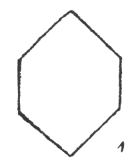
Now we will go a step further, to something very seldom noticed because one does not stop to think about it. Having transformed the food by means of its own bodily substances into wax—this the bee produces out of itself—the bees now makes a special little container in which to deposit its egg or in which to store up food supplies. This special little vessel is, I should like to say, a really great marvel, It appears to be hexagonal when we look at it from above; looked at from the side it is closed in this way. (Diagram 1 and Diagram 2.) Eggs can be deposited there, or food can be stored. Each vessel lies next to another; they fit extremely well together, so that this “surface” by which one cell, (for so it is called), is joined to another in the honey-comb, is exceedingly well made use of—the space is well used.
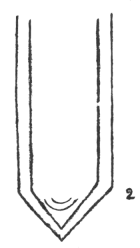
When the question is raised how can the bee instinctively build so skilfully formed a cell, people generally answer: “It is done that the space may be thoroughly well used.” That is true. If you try to imagine any other form of cell there would always be spaces, everything is joined together so that every part of the surface of the comb is completely made use of.
This certainly is one reason, but you see it is not the only reason. We must consider how the little larva which lies within it is entirely isolated, and one must not by any means believe that anything exists in Nature that is without forces. This six-angled, six-surfaced dwelling has certain forces within it; it would be quite another matter if the larva were to occupy a round one. In Nature it signifies something quite definite that it lies within this six-surfaced little dwelling-place. The larva receives the forces of the form later it feels in its body that it was once in this hexagonally-formed cell, in its youth when it was quite soft.
The bee is afterwards able to build similar cells out of the same forces which it thus absorbed. There lie the forces through which the bee afterwards works, for what the bee makes externally lies in its environment.

This is the first thing we must notice. Now there is another very remarkable fact that has been described to you. In the hive there is a variety of cells. I think every bee-keeper can well distinguish between the cells of the worker-bees and those of the drones. This is not a difficult matter, is it? It is still easier to distinguish between the cells of worker-bees and drones and those of the Queens, for the latter have not at all this form, they are more like a sack. The Queen cells have no such shape, they are more like a kind of sack; also there are very few of them in the hive. So we must say: The worker-bees and the drones (the males) develop-in hexagonal cells, but the Queen is developed in a “sack.” She is not at all concerned to have hexagonal surroundings. (Diagram 3 and Diagram 4).
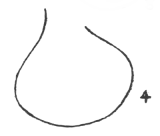
Then we must consider something else. You see, the Queen for her development, i.e. until she is a complete full-grown insect, needs only sixteen days. She is then fully matured. A worker bee requires about twenty-one days to mature, which is a longer period. One might say that Nature bestows much more care on the development of the worker-bee than on that of the Queen.
But we shall soon see that quite another reason comes in question. The worker-bee then, needs twenty-one days, and the drone, the male—which will finish its task soonest of all—needs twenty-three to twenty-four days. The males are killed when they have fulfilled their task.
We have quite a new situation here. The different kinds of bees—Queens, workers and drones—all need a different number of days for their development.
Well, let us consider these twenty-one days needed by the worker-bees. There is something very special about this. A period of twenty-one days is not without meaning for what happens on the earth. Twenty-one days are equal to the period of time during which the Sun, approximately speaking, revolves once upon its own axis.
Now think, the worker-bee takes just that period of time for its development which the Sun takes to turn upon its axis. The worker-bee experiences one revolution of the Sun, and because it has experienced one complete revolution it enters into all the Sun can give.
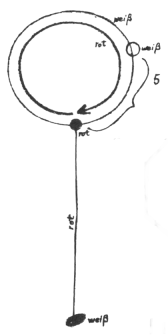
If it wished to go further it would always meet only with the same Sun-influences, for if you picture to yourselves here the worker-bee, [Dr. Steiner draws on the blackboard.] (Diagram 5) and here the Sun at the moment when the egg is laid, then here we shall have the point exactly opposite the Sun. The Sun revolves upon its own axis once in twenty-one days; then it returns again and the first point is again here. If this were to continue, only such Sun-workings would be there as had once been there already. So the worker-bee by the time it is fully developed has experienced all that the Sun can give. Should the worker-bee continue to develop it must leave the Sun and enter the earth development; it will then no longer be having a Sun-influence in its development because it already had this, and has tasted it to the full. Now it passes into the earth development, but only as a perfect insect, as a matured creature. I might say—the worker-bee occupies herself only momentarily with this earth-development, and has then finished with her Sun-development, is entirely a creature of the Sun.
Now let us look at the drone. The drone, I might say, considers the matter a little longer. It does not think itself quite ready after twenty-one days, so before it is fully matured it enters the earth-development. The drone is thus an earthly being, whereas the worker-bee is entirely a child of the Sun.
How is it with the Queen? The Queen-bee does not even go through the whole of the Sun-revolution, but stays behind and remains always a creature of the Sun. For this reason the Queen is much nearer to her larval state than the others; the drones (the males) are the farthest removed from the larval state. The Queen is thereby able to lay eggs. In the bees it is clearly to be seen what it signifies to be exposed to the earth-influence or to the Sun-influence. As you know, it depends entirely on whether the bee completes, or does not complete its Sun-development, that it becomes either a Queen, a worker or a drone. The Queen lays eggs, and it is because she remains always under the influence of the Sun and receives nothing from the earth that she is enabled to do so. The worker-bee goes a little further and develops for another four or five days; it tastes the Sun to the full. But then, just when its body becomes firm enough it goes over, just for a moment, as I said, into the earth-development. Thus the worker-bee cannot return again to the Sun, for it has already thoroughly absorbed its influences. Consequently the worker-bee cannot lay eggs.
The drones are the males; they can fertilise; this power of fertilisation comes from the earth; the drones acquire it in the few days during which they continue their growth within the earth-evolution and before they reach maturity. So we can now say: in the bees it is clearly to be seen that fertilisation (male fecundation) comes from the earthly forces, and the female capacity to develop the egg comes from the forces of the Sun. So you see, you can easily imagine how significant is the length of time during which a creature develops. This is very important for, naturally, something happens within a definite time which could not occur in either a shorter or a longer time, for then quite other things would happen.
But there is something further to be considered. You see, the Queen develops in sixteen days. Then the point which stood opposite to her in the Sun is perhaps only here; [Drawing on the blackboard.] (Diagram 5) the Queen remains within the Sun-development. The remaining part of the Sun's course is gone through by the worker-bees, but they too remain within the Sun-development; they do not really pass out of it to the earth. And so, you see, they feel themselves entirely akin to the Queen because they belong to the same Sun-influence; the whole host of the worker-bees feel themselves related to the Queen. They say:—“The drones are betrayers; they have fallen to the earth. They no longer belong to us; we suffer them only because we need them.”
For what are they needed?
As you know, it sometimes happens that the Queen is not fertilised; nevertheless she lays eggs. The Queen need not necessarily be fertilised to lay eggs. Then we have what is called “virgin-brood.” This also happens with other insects; the scientific name for it is parthenogenesis. But only drones can emerge from these unfertilised eggs; no workers and no Queens. Thus when a Queen is unfertilised, worker-bees and Queens do not hatch out, only drones; such a colony is naturally useless.
You see, in “virgin-brood” only the opposite sex is produced, not the same sex. This is a very interesting fact, and an important one in the whole household of Nature—namely, that fertilisation is necessary if the same sex is to come into being (this applies to the lower animals of course, not to the higher ones). With the bees it is the case that only drones emerge where fertilisation has not taken place.
This fecundation of the bee is indeed a very special affair; there is nothing like a marriage-bed to which one retires, it all takes an entirely different course. It takes place openly, in the full sun-light and, though this may seem very strange at first, as high as possible in the air. The Queen-bee flies as far as possible towards the Sun to which she belongs. (I have already described this to you), and that drone alone which can overcome the earthly forces—for the drones have united themselves with the earthly forces—only that drone which can fly the highest is able to fecundate the Queen up there in the air.
The Queen returns and lays her eggs. So you see, the bees have no marriage-bed, they have a marriage flight; they must strive as far as they are able, towards the Sun. One must have, is it not so, fine weather for this marriage flight which really needs the Sun? In had weather it cannot take place.
Now all this shows you how closely the Queen remains related to the Sun. When fertilisation has taken place, then worker-bees emerge from the worker-cells; first the little larva appear, as Herr Müller has so well described, and then after twenty-one days develop into worker-bees. In the sack-like cells a Queen develops.
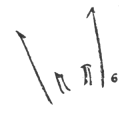
Now if we are to go further, I must tell you something you may naturally receive with some doubt, for it needs exact study. Nevertheless, it really is so. I will link this further matter to the following:—The worker-bee now mature and ready, sets out on its flight, visiting the flowers and trees to which it attaches itself by the minute hooks on its feet. (Diagram 6) It gathers both nectar and pollen. The pollen is carried on the body where there is a special contrivance for depositing it; the nectar it sucks up with its tongue. A part of the nectar is used for its own food, but the greater part is retained and this, on its return to the hive, the bee spits out. Actually, when we eat honey we eat the spittle of the bee; we must be quite clear as to this, but it is a very clean and sweet spittle.

Thus the bee gathers all it needs for food, for storing, and for further elaboration into wax, etc. Now we must ask ourselves, how does the bee find its way to the flowers? It finds its way to the flowers with absolute certainty, but one is quite unable to explain this by merely observing the eyes of the bee. The worker-bee (the drone has somewhat larger eyes), has only two small eyes, one at each side, and three quite minute ones on the forehead (Diagram 7). The drones have rather larger eyes. But when one studies these two eyes of the bee, one discovers that it sees very little with them, and that with the three minute frontal eyes it sees, to begin with, nothing at all. That is the strange thing that the bee does not find the flowers by sight, but by a sense more like the sense of smell. It finds its way to the flowers by a sense which is between taste and smell, on its flight it already, as it were, tastes the pollen and the nectar. From far away it tastes them, so the bee has no need to use its eyes at all.
Now make for yourself a clear picture of the following.
Think of a Queen-bee born in the realm of the Sun, and not having tasted the Sun's working to the full, has remained, so to speak, entirely under the influence of the Sun. The whole host of the worker-bees, though it has completed the course of the Sun's revolution, has not actually passed over to the earth development. These worker-bees feel themselves united with the Queen, not because they were under the same Sun, but because they remained within the Sun-development; this is why they feel themselves so united with the Queen. In their development they did not sever themselves from that of the Queen. The drones do not belong to them; they have separated themselves.
But now the following happens. In order that a new Queen can come into being, the marriage flight must have taken place. The Queen goes out into the Sun. A new Queen comes into being. At that moment a most remarkable thing happens to the whole host of the workers who feel themselves so united with the old Queen. Their tiny little eyes begin to see when the new Queen is born. This they cannot endure; they cannot endure that that which they themselves are, should come from elsewhere. The three minute frontal eyes, these three very small eyes of the worker-bees, are built up from within; they are permeated with the inner blood and so on, of the bee; they were never exposed to the external working of the Sun. But now the new Queen is born from out of the Sun, and brings Sun-light with her own body into the hive; now the bees become—I should like to say—clairvoyant with their little eyes. They cannot endure this light of the new Queen. The whole host of them prepares to swarm. It is like fear of the new Queen, as though they were dazzled. It is as though we were to look at the Sun itself.
That is why the bees swarm. And now one has once more to re-establish the colony on the basis of the majority of the worker-bees which still belong to the hive—that is, to the old Queen. The new Queen must find a new people. A part of the population of the hive has of course, remained behind, but these are those born under different circumstances. The reason why the bees swarm lies in the fact that the workers cannot endure the new Queen who brings in a new Sun-influence.
Now you might ask, “Why should the bees feel so sensitive towards this new Sun-influence?” This is indeed a very strange thing. No doubt you know that it is sometimes not at all pleasant to meet a bee; it may sting one. If one is so large an animal as man at the worst one gets an inflamed skin; all the same it is rather unpleasant. Smaller animals may even die from the sting of a bee. This is due to the fact that the sting is really a tube in which a kind of piston moves up and down, which is connected with a poison bag. This poison (very disagreeable to one who has to experience it) is however, of great value to the bees. It is by no means pleasant for the bee to have to part with its poison, and in reality it only does so because it cannot bear that any influence from outside should approach. The bee wants always to remain within itself, to stay within the sphere of its own substance. Every external influence is felt as disturbing, as something to be warded off by its poison. But this poison has at the same time quite another significance, for in the minutest quantities it continually passes over into the whole body of the bee; without it the bee could not exist at all.
One must understand in studying the worker-bee that it is unable to see with its small frontal eyes, and that this is due to the fact that the poison continually permeates these frontal eyes. The moment the new Queen appears with her new Sun-influence, this poison is harmfully affected. It ceases to be active, and the small eyes suddenly begin to see, for the fact that the bee lives its life in a perpetual twilight is due to the poison.
If I were to describe to you in a pictorial form what the bee experiences when a new Queen slips out of her sack-like cell, I should have to say: “The bee lives always in the twilight, and finds its way about by means of a sense between taste and smell; it lives in a twilight congenial to it. But when the new Queen appears it is exactly like when we walk in the twilight of a June evening, and the little glow-worms are shining.” Even so does the new Queen shine for the swarm, because the poison does not work strongly enough to keep the bees in their twilight seclusion from the world. It keeps within it even when it flies out, because it is then able with its poison to keep within itself. It needs the poison when it fears something from outside may disturb it. The whole colony desires to be entirely within itself.
Indeed, in order that the Queen may remain in the sphere of the Sun she may not dwell in an angular cell, but within a circular one. There she remains within the Sun-influence.
Here we touch upon something that makes bee-keeping so extremely interesting for everyone. For you see, in reality, things go on in the hive in exactly the same way as in the human head, only with a slight difference. In our head, for instance, the substances do not grow to such dimensions. In the human head we have nerves, blood-vessels, and the separately situated round-shaped cells which are always to be found. We have these three varieties of cells in the human head. The nerves consist of separate cells which only do not grow into independent beings because Nature encloses them on all sides; in reality, however, these nerves would like to become little animals. If the nerve-cells of the human head could develop in all directions, under the same conditions as those of the hive, then the nerve-cells would become drones.
The blood-cells which flow in the veins would become worker bees; and the single free cells which are, above all, in the centre of the head and go through the shortest period of development, may be compared with the Queen bees.
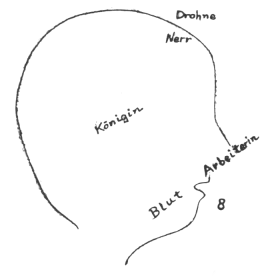
So in the human head we have the same three forces (Diagram 8) as in the hive.
Now the workers bring home what they gather from the plants, and work it up in their own bodies into wax, of which they then build the wonderful structure of the combs. The blood-cells of the human head however, do the same thing. From the head they pass into the whole body. When you look for instance, at a bone, at a piece of bone, you will find hexagonal cells everywhere. The blood that circulates through the whole body carries out the same work that is done in the hive by the bees. It is similar with the cells of our muscles which, once more, correspond to the wax-cells of the bees, but these cells being softer, dissolve more quickly, so it is here less noticeable. A study of the bones shows it very well. Thus, the blood has the same forces as those of the worker-bee.
One can even follow their development through the course of time. The cells which you find first developed in the human embryo, and which subsequently remain unchanged, are those that already exist in the early stages of embryonic life. The others, the blood-cells, come into existence somewhat later, and finally the nerve-cells are developed—just as with the bee-hive. Only man builds up a body which obviously belongs to him; the bee also builds up a body, but for the worker-bees, this body is the honey-comb—the cells. This building of the comb corresponds to what happens within our bodies,—namely, that the blood-cells in reality do this out of a kind of wax—but here it is not so easy to prove.
We ourselves are made of a kind of wax, just as the honey-comb forms the marvellous structure we find in the skep or hive.
So this is how it is. Man has a head, and this head works upon his great body which is actually a “bee-hive” and contains in its relationship between the albuminous cells (which remain round) and the blood, the same connection that exists in the bee-hive between the Queen and the worker-bees. Our nerves are continually destroyed; we continually use up our nervous system. We do not immediately kill our nerves—as the bees kill the drones—for in this case we should die every year, but, none the less, our nerves get weaker every year, and it is through this gradual weakening of the nerves, that man really dies. We are then no longer able to experience our body rightly; a man is actually always dying from the wearing out of his nerves.
When you look at the head—which represents the hive—you find that here all is well protected. If one injures one's head, it is a serious matter; the head cannot bear it. Equally, what happens through the presence of the new Queen—who is there by reason of the marriage flight—is something the bees cannot endure; they prefer to go away rather than remain with her.
This is why bee-keeping has always been regarded as profoundly significant. Man takes away from the bees—perhaps 20% of their honey—and one can justly say that this honey is extremely valuable to man, for with his ordinary food he gets very little honey because honey is distributed in such very small quantities in the plant-world. We get only minute quantities of honey into our bodies in this way.
We also have “bees” within us, namely, our blood, which carries the honey to the various parts of our body. It is honey that the bee needs for producing wax, out of which it then makes the “body” of the colony.
As we grow older, honey has an extremely favourable effect upon us. With children, it is milk that has a similar effect; honey helps us to build our bodies and is thus strongly to be recommended for people who are growing old. It is an exceedingly wholesome food; only one must not eat too much of it! If one eats too much of it, using it not merely as a condiment, one can make the formative forces too strongly active. The form may then get too rigid, and one may develop all kinds of illnesses. A healthy man feels just how much honey should take. Honey is particularly good for older people because it gives the body the right firmness.
One should also adopt the plan of giving just the right quantity of honey to children suffering from rickets when they are nine to ten months of age, and continue this honey diet till the age of three or four years. Rickets would then not be as bad as it is, for this illness consists in the body being too soft, and collapsing. Of course, in the very first weeks children ought only to be given milk; honey would at that age have no affect. Honey contains the forces that give man's body firmness. These things should be understood.
So one can say that much more attention should be given to the keeping of bees than is usual.
The following is also possible. In Nature everything is wonderfully inter-related. In Nature the laws which man is unable to penetrate with his ordinary intelligence are the most important. These laws work—do they not?—always with a perfect freedom. This holds good for instance, with the proportion of the sexes on earth. This is not always the same, the number of men and women is not always, but only more or less an equal one; it is approximately equal over the whole earth. This is brought about in the wisdom of Nature. If it should ever come about—I believe I have already told you this—that men were ultimately able to determine the whole matter arbitrarily, then everything would fall into confusion. If in any country the population has been decimated by wars it will afterwards become more numerous. In Nature, every need calls forth the working of opposite forces.
Now, when the bees seek nectar from the plants, they naturally take this from plants which have also other uses—which give us fruits and so on. But the remarkable thing is that fruit-trees thrive much better in places where bees are kept, than in places where there are no bees.
When the bees take the nectar from the plants Nature does not remain idle, but produces more fruitful plants. So man not only benefits by the honey the bees make, but receives more from the plants visited by the bees. This is a law of great importance, and one we can well understand.
Observing things in this way, one is able to say—in the whole inter-relationship of the bee-colony—of this organism—Nature reveals something very wonderful to us. The bees are subject to forces of Nature which are truly wonderful and of great significance. One cannot but feel shy of fumbling among these forces of Nature. It is becoming increasingly obvious today that wherever man clumsily interferes with these forces he makes matters not better, but worse. He does not make them worse all at once, for it is really so that Nature is everywhere hindered, though notwithstanding these hindrances Nature works as best she may. Certain of these hindrances man can remove, and by doing away with them can make things easier for Nature. For example, he seems actually to be helping Nature when he makes use of bee-hives which are conveniently arranged, instead of using the old straw skeps.
But here we come to the whole question of artificial bee-keeping. You must not think that I am unable to see—even from a non-anthroposophical point of view—that modern bee-keeping methods seem at first very attractive, for certainly, it makes many things much easier. But the strong holding together—I should like to say—of one bee-generation, of one bee-family, will be impaired in the long run.
Speaking generally today, one cannot but praise modern bee-keeping; so long as we see all such precautions observed of which Herr Müller has told us, we must admire them in a certain sense. But we must wait and see how things will be in fifty to eighty years time, for by then certain forces which have hitherto been organic in the hive will be mechanised, will become mechanical. It is not possible to bring about that intimate relationship between the colony and a Queen that has been bought, which results naturally when a Queen comes into being in the natural way. Only, at first these things are not observed.
Of course, I by no means wish that a fanatical campaign in opposition to modern bee-keeping should be started, for one cannot do such things in practical life. To do so would be rather like something I will now tell you. It is possible to calculate approximately the time when there will be no more coal in the earth. The coal supply of the earth is exhaustible; one day it will come to an end. Now it would be quite possible to limit the amount of coal taken out of the earth, so that the supply would last as long as the earth itself. One cannot say that we ought to do so, for we should have a little faith for the future. One says “Well, of course we rob the earth of its coal, that is we rob our descendants of coal, but they will be able to invent something else so that they will not need coal any longer.” Naturally, one can say the same about the disadvantages of modern bee-keeping!
Still, it is well to be aware of the fact that by working mechanically we destroy what Nature has elaborated in so wonderful a way. You see bee-keeping has at all times been highly valued; in olden times especially, the bee was held to be a sacred animal. Why? It was so considered because in their whole activity, processes reveal themselves which also take place in man himself. If you take a piece of bees-wax in your hand you are in reality holding something between blood, muscle and bone, which in man's inner organisation passes through the stage of being wax. The wax does not however become solid, but remains fluidic till it is transformed into blood, or muscles, or into the cells of the bones. In the wax we have before us what we bear within us as forces, not as substance.
When men in olden times made candles of the bees-wax and lighted them, they knew that they performed a wonderful and sacred action: “This wax which we now burn we took from the hive; there it was hardened. When the fire melts it and it evaporates, then the wax passes into the same condition in which it is within our own bodies.”
In the melting wax of the candle men once apprehended something that rises up to the heavens, something that was also within their own bodies. This awoke a devotional mood in them, and this mood in its turn led them to look upon a bee as a specially sacred creature, because it prepares something which man must continually work out within himself. For this reason, the further back we go the more we find how men approached the bees with reverence. Of course, this was when they were still in their wild state; men found it so, and they looked upon these things as a revelation. Later they brought the bees into their household.
Quite wonderful riddles lie concealed in all that happens with the bees, and by much studying of them one can learn to know what happens between the head and the body in man.
I have now told you a few of those things I wished to speak of. On Wednesday we shall have our next meeting, and perhaps many questions will have arisen. Something may occur also to Herr Müller.
Today I only wished to make these remarks which, after all, are beyond doubt, for they are founded on real knowledge. But, there may still be much that can be made clearer.

